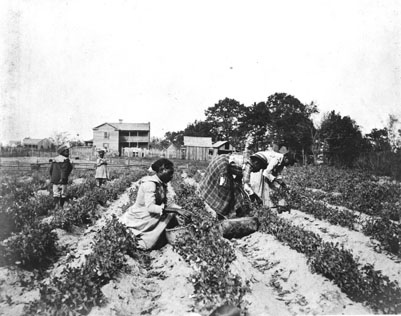Sharecropping
See also: Crop Lien System. 
Sharecropping was the mode of labor that supported much of North Carolina's postslavery plantation economy. During Reconstruction, this system of tenant farming offered both planters and laborers, African Americans as well as some poor whites, incentives over the gang labor that predominated during slavery. Planters, strapped for cash in a postbellum economy where money was scarce, offered laborers housing, a mule, tools, and seed to farm a small plot of the planter's land. In return, the sharecropper bought provisions on credit from the planter and reserved the sale and one-half to three-quarters of the crop for the planter. For laborers, sharecropping eliminated the pain and humiliation of gang labor and allowed freedmen to move their families out from direct supervision of white supervisors.
Despite the benefits some sharecroppers accrued from the system, planters profited more. Employers throughout the South constructed a form of sharecropping that contributed to the horrific poverty of African Americans in the region. Planters, faced with a severe labor shortage at the close of the Civil War, used sharecropping to develop a labor-repressive economy that enabled landowners to maintain economic and political dominance. Sharecropping contracts, designed for a year-long obligation, favored the rights of employers; and Freedmen's Bureau agents, ostensibly the freedmen's advocate, often encouraged freedmen to sign contracts in order to restore stability and order to otherwise chaotic economic conditions. North Carolina laws reinforced planter dominance over croppers. The law defined sharecropping as wage labor. Therefore, croppers were subjected to more managerial supervision than tenants who merely rented land from planters and provided their own supplies. Furthermore, crop lien legislation gave landlords control over the crops, which prevented croppers from selling their goods to merchants elsewhere for better prices.
Economic conditions worsened in the 1880s and 1890s as cotton prices plummeted from 18 cents a pound in 1868 to 5 cents a pound in 1894. North Carolina's poor economic infrastructure offered few forms of credit. The crop lien system intensified laborers' misery as sharecroppers, bound to planters and merchants, pledged their growing crops for food and supplies at interest rates that ranged from 25 percent to 100 percent. By the 1890s, many yeomen, tenants, and sharecroppers revolted against landholders by forming Farmers' Alliances, which established the Populist Party in the mid-1890s. Black and white yeomen, tenants, and croppers drew together to promote reform policies that included the Subtreasury Plan, a system of warehouses intended to store crops until market prices improved. Eventually, the Populist Party dissipated due to friction between leaders, who usually owned land, and rank-and-file tenants and sharecroppers.
Over time, sharecropping declined. New Deal policies and surges in the African American population reversed labor shortages, which enabled planters to turn back to a wage labor system. Programs such as the Agricultural Adjustment Act discouraged farming and released many sharecroppers into the already growing pool of unemployed laborers. Mechanical harvesters further reduced planters' needs for labor. Temporary wage labor proved cheaper than sharecropping contracts, which required year-round management. During World War II, African Americans began to migrate to northern cities for industrial jobs. As the United States embarked upon the postwar years, North Carolina, no longer in need of labor-repressive laws, developed wage labor policies in favor of industrial development.
Educator Resources:
Grade 8: From Slavery to Sharecropping. North Carolina Civic Education Consortium. http://civics.sites.unc.edu/files/2012/04/Sharecropping.pdf
References:
Dwight B. Billings Jr., Planters and the Making of a "New South": Class, Politics, and Development in North Carolina, 1865-1900 (1979).
Margaret Jarman Hagood, Mothers of the South: Portraiture of White Tenant Farm Women (1939).
Gerald David Jaynes, Branches without Roots: Genesis of the Black Working Class in the American South, 1862-1882 (1986).
Roy G. Taylor, Sharecroppers: The Way We Really Were (1984).
Additional Resources:
The Depression for Farmers, LearnNC: http://www.learnnc.org/lp/editions/nchist-worldwar/5955
Sharecropping and Tenant Farming, LearnNC: http://www.learnnc.org/lp/editions/nchist-newsouth/4698
Image Credit:
From the General Negative Collection, North Carolina State Archives, call #: N_83_7_30, Raleigh, NC. Available from https://www.flickr.com/photos/north-carolina-state-archives/5573813181/ (accessed September 10, 2012).
1 January 2006 | Zipf, Karin Lorene